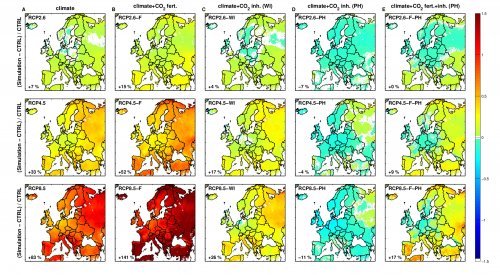In this study we used the MEGAN (Model of Emissions of Gases and Aerosols from Nature) emission model coupled with the MOHYCAN (Model of HYdrocarbon emissions by the CANopy) canopy model to calculate the isoprene fluxes emitted by vegetation in the recent past (1979–2014), and in the future (2070–2099) over Europe.
As a result of the changing climate, modeled isoprene fluxes increased by 1.1% per year on average in Europe over 1979–2014, with the strongest trends found over eastern Europe and European Russia.
For the 1979–2014 period the model used ECMWF meteorology, whereas for the comparison of current with projected emissions, the meteorology was simulated by the ALARO climate model.
Depending on the climate scenario, isoprene fluxes were found to increase between 7% and 83% compared to the control run, and even stronger increases were found when considering the potential impact of CO2 fertilization. However, the inhibitory CO2 effect goes a long way towards canceling these increases.
References
- Bauwens, M., Stavrakou, T., Müller, J.-F., Van Schaeybroeck, B., De Cruz, L., De Troch, R., Giot, O., Hamdi, R., Termonia, P., Laffineur, Q., Amelynck, C., Schoon, N., Heinesch, B., Holst, T., Arneth, A., Ceulemans, R., Sanchez-Lorenzo, A., Guenther, A. (2018). Recent past (1979–2014) and future (2070–2099) isoprene fluxes over Europe simulated with the MEGAN–MOHYCAN model. Biogeosciences, 15(12), 3673–3690. https://doi.org/10.5194/bg-15-3673-2018


